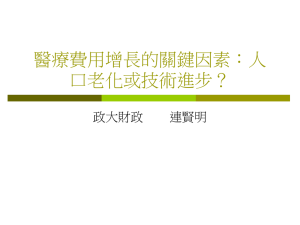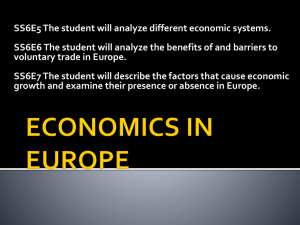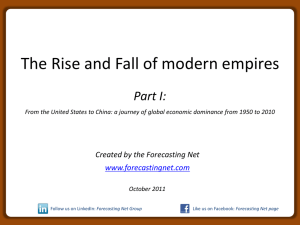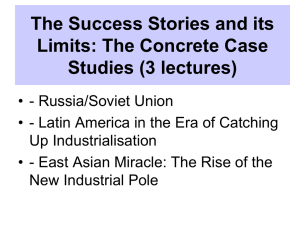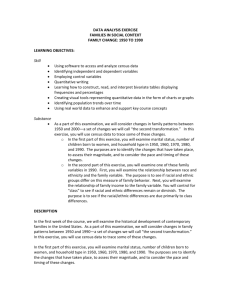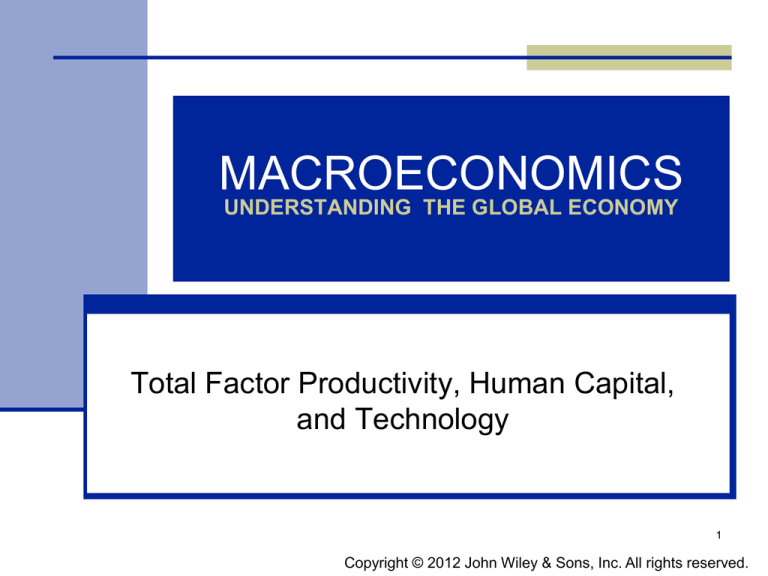
MACROECONOMICS
UNDERSTANDING THE GLOBAL ECONOMY
Total Factor Productivity, Human Capital,
and Technology
1
Copyright © 2012 John Wiley & Sons, Inc. All rights reserved.
5-2
Key Concepts
Total Factor Productivity
Human Capital
Technological Progress
Foreign Direct Investment
5-3
Effect of shift in production function
Real GDP
Production Function, New
Production Function, Old
Depreciation
Investment, New
Investment, Old
K0
K1
Capital
5-4
Production Function Shift
Increase in Output due to function shift
Increase in Labor
Increase in TFP
Increase in Output due to increase in capital
Economy moves to new steady state
As capital increases, output increases
Why does production function shift?
5-5
Human Capital
Skills and knowledge that accumulate over
time, embodied in people
© Shutterstock Images
5-6
Human Capital
GDP per capita =
GDP
H ours
H ours
N um ber Em ployed
N um ber Em ployed
Labor Force
Labor Force
Population
Human Capital increases Labor Productivity
5-7
More human capital
Real GDP
Output, High Human Capital
Output, Low Human Capital
Depreciation
Investment, High
Investment, Low
KLow
KHigh
Capital
5-8
Human Capital
Increase means more output, even at current
levels of physical capital and labor
Increase means higher steady state level of
output and capital
May explain cross-country growth differentials
5-9
Education and Economic growth
Conditional Growth of GDP per Capita 19602000
5
Korea
4
USA
Switzerland Austria
Portugal
Ireland
FranceJapan
Iceland Spain Finland
Norway Italy Canada
Denmark
Sweden Netherlands
Australia
UK
3
2
Mexico
Greece
Turkey
N. Zealand
1
0
420
440
460
480
500
520
Conditional Student Acheivement Test Score
540
560
5-10
Contribution to Growth
Contribution of Education to Annual Output Growth,
1950 – 1990
5-11
How to increase human capital?
Educational attainment
Expenditures on education
Allocation of resources
Level of education
Cost of education
5-12
Schooling Differences Across
Countries
14
Primary
Secondary
Tertiary
12
10
8
6
4
2
Years of Education by level
1950
1980
2010
1950
1980
2010
Russia
1950
1980
2010
UK
1950
1980
2010
USA
1950
1980
2010
France Germany Japan
1950
1980
2010
1950
1980
2010
1950
1980
2010
1950
1980
2010
Canada
1950
1980
2010
1950
1980
2010
0
India
China
Brazil
Kenya
5-13
Percentage of students completing the
final year of primary school
Source: World Bank Millennium Development Goals
5-14
Education Spending and Attainment
550
Korea
Maths test score
Czech
500
Poland
Slovakia Hungary
Finland
Switz.
Netherlands
N. Zealand Japan
Belgium
Australia
Denmark
Germany
Austria
Sweden Iceland
Ireland
UK
France
Norway
Spain
USA
Portugal
Greece
Italy
450
Turkey
Mexico
400
0
20000
40000
60000
80000
100000
Cumulative spending per student (from age 6 to 15, 2006 US Dollars)
5-15
Determinants of Efficient
Education Expenditure.
5-16
Review
Cross-country differentials in per capita
output are substantial
Role of physical capital
Role of human capital
Significant fraction of differential is
unexplained – we call this “TFP”
Other elements of TFP
5-17
TFP important
5-18
Institutions
Property Rights
Regulatory Institutions
Macroeconomic Stabilization
Social Insurance
Conflict Management
Political Rights
5-19
World Bank Indicators
Voice and accountability
Political stability and lack of violence
Government effectiveness
Regulation quality
Rule of law
Corruption
5-20
Governance and GDP
100000
Luxembourg
GDP per cpita (2000 $, log scale)
USA
UK
Italy
Spain Greece
10000
Japan
GermanyFinland
Canada
France Australia
Argentina
Eq. Guinea
Venezuela
Chile
Turkey Malaysia
Brazil
Russia
Iran
Bulgaria
China
Ukraine
1000
Iraq
Philippines
India
Nigeria
Zambia
Zimbabwe
Ghana
Ethiopia
Malawi
Burundi
100
-2
-1.5
-1
-0.5
0
0.5
Aggregate Governance Score
1
1.5
2
5-21
Corruption Perceptions Index
(higher score = less corrupt)
Country
Denmark
N. Zealand
Singapore
Sweden
Canada
Netherlands
Australia
Hong Kong
Germany
Japan
UK
Chile
US
France
Spain
Poland
S. Africa
Malaysia
Italy
Brazil
Score
9.3
9.3
9.3
9.2
8.9
8.8
8.7
8.4
7.9
7.8
7.6
7.2
7.1
6.8
6.1
5.3
4.5
4.4
3.9
3.7
Country
China
Thailand
Greece
India
Mexico
Argentina
Indonesia
Ethiopia
Vietnam
Nigeria
Ukraine
Pakistan
Kenya
Russia
Venezuela
Sudan
Iraq
Afghanistan
Myanmar
Somalia
Score
3.5
3.5
3.5
3.3
3.1
2.9
2.8
2.7
2.7
2.4
2.4
2.3
2.1
2.1
2.0
1.6
1.5
1.4
1.4
1.1
5-22
Bribe Payers Index
(higher figure = less likely to bribe)
Country
Belgium
Canada
Netherlands
Switzerland
Germany
UK
Japan
Australia
France
Singapore
US
Score
8.8
8.8
8.7
8.7
8.6
8.6
8.6
8.5
8.1
8.1
8.1
Country
Spain
Hong Kong
South Africa
South Korea
Taiwan
Italy
Brazil
India
Mexico
China
Russia
Score
7.9
7.6
7.5
7.5
7.5
7.4
7.4
6.8
6.6
6.5
5.9
5-23
Rent Seeking
Activity in which value-added produced by
one person is taken by another
Examples
Water subsidies
Sugar tariffs
Insider contracts or trading
Concerns
Absorbs resources (labor and capital)
Acts as a tax
Rent seeking crowds out production
5-24
R&D
Growth can be sustained through
technological progress
Role of Research and Development in
promoting technological progress
Example of South Korea
© Shutterstock Images
5-25
South Korean R&D as a % of GDP
% of GDP
3
2
1
0
1967
1972
1977
1982
1986
1990
1994
1998
2002
2006
2008
As countries approach their steady state, R&D
becomes more important.
5-26
Rich countries spend more on R&D
102400
51200
USA
UK
GDP per capita $
25600
Japan
Sweden
France Germany
Kuwait
Israel
S. Korea
12800
Czech
6400
3200
Russia
China
1600
800
India
400
Uganda
200
100
0
0.5
1
1.5
2
2.5
3
3.5
R&D Expenditure (% of GDP)
4
4.5
5
5-27
Foreign Direct Investment
Investment by foreign firms in an economy
Encourages capital accumulation and
technology transfer
Can facilitate convergence among countries
5-28
Foreign Direct Investment (FDI)
Net Foreign Direct Investment, (billions of US $)
5-29
Summary
Effect of increases in TFP
Effect of human capital accumulation
Other influences on growth
Institutions
Technological Progress
FDI
Copyright © 2012 John Wiley & Sons, Inc. All rights reserved. Reproduction or translation of this work beyond that permitted in
Section 117 of the 1976 United States Copyright Act without the express written permission of the copyright owner is unlawful.
Request for further information should be addressed to the Permissions Department, John Wiley & Sons, Inc. The purchaser
may make back-up copies for his/her own use only and not for distribution or resale. The Publisher assumes no responsibility for
errors, omissions, or damages caused by the use of these programs or from the use of the information contained therein.

